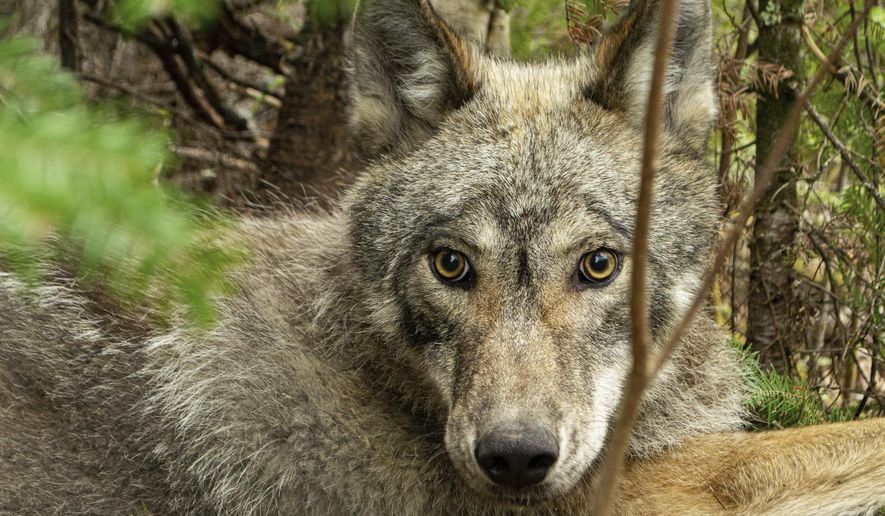Environmental groups filed two lawsuits Thursday to halt the Trump administration’s decision last year removing federal protections for the gray wolf, arguing that the apex predator has yet to finish its comeback story.
The gray wolf exceeded expectations after being reintroduced to the Northern Rocky Mountains in 1995, with more than 6,000 wolves now in the lower 48 states, but wildlife advocates argued that the species has yet to be recovered fully in its historic Western range.
“From a scientific standpoint, wolves are nowhere near being recovered in the western United States,” said Erik Molvar, wildlife biologist and executive director with Western Watersheds Project. “The federal government has the obligation to keep wolves protected until robust and secure populations are in place throughout the West, and we intend to ensure that wolves get the legal defense they need against premature delisting.”
His group and eight others were represented by the Western Environmental Law Center. A separate lawsuit challenging the wolf delisting was brought by national environmental groups represented by Earthjustice.
Both were filed in U.S. District Court for Northern California.
Interior Secretary David Bernhardt announced on Oct. 29 that the gray wolf would be removed from the endangered species list in what was declared a conservation triumph, drawing cheers from state and local officials concerned about the hit to livestock as well as to deer and elk herds.
Fish and Wildlife Service spokesperson Vanessa Kauffman defended the delisting decision, saying it reflected the “best scientific and commercial data available.”
“After more than 45 years as a listed species, the gray wolf has exceeded all conservation goals for recovery,” she said in a Thursday email. “This action reflects the determination that this species is neither a threatened nor endangered species based on the specific factors Congress has laid out in the law.”
There are two major wolf populations in the lower 48 states: the Western Great Lakes and the Northern Rocky Mountains. Environmentalists pointed out that the lion’s share, or 4,400, inhabit the Great Lakes states.
Meanwhile. wolves on the Pacific Coast lag far behind those in the Northern Rockies.
About 108 wolves have made their way to Washington state, with 158 in Oregon and 15 in California. All three states have listed the gray wolf as endangered under state law.
“With only a handful of wolves in California, western Oregon, and western Washington, wolf recovery is still precarious on the west coast,” said John Mellgren, Western Environmental Law Center general counsel. “A rush to delist the species across the entire country runs counter to the Service’s own peer review, and tells West Coast states that wolf recovery in their part of the country does not matter.”
BREAKING: Big coalition repped by @westernlaw filing suit over #Wolf delisting. #EndangeredSpeciesAct #SaveWolves https://t.co/gyFTvBoO0S
— Western Watersheds (@wildadvocate) January 14, 2021
The agency has argued that the Endangered Species Act “does not require wolves to be present throughout all of its former range, or for populations to be at historic levels for delisting to occur.”
“The measure under the ESA is whether wolves are in danger of extinction (endangered) or at risk of becoming so in the foreseeable future (threatened) throughout all or a significant portion of its range,” said an FWS October fact sheet. “By any scientific measure, gray wolves no longer meet the ESA’s standard for protection and so should be delisted.
The gray wolf population had dwindled in the lower 48 states to about 1,000 before being listed under the ESA in 1974. About 50 species have been declared recovered since the law was passed in 1973, including 13 in the Trump administration.
Wildlife groups raised concerns about state management of the wolf populations, particularly in states that allow hunting, including Idaho, Montana and Wyoming. After the delisting was announced, Wisconsin said it would hold in 2021 its first wolf hunting season since 2014.
Idaho Fish and Game reported 570 wolves killed in 2019-20 by hunters and traps, as well as vehicles and other causes.
“Returning this type of unscientific and barbaric ‘management’ to states at this early juncture would spell disaster for true gray wolf recovery, plain and simple,” said Lindsay Larris, WildEarth Guardians wildlife program director.
The Fish and Wildlife Service has sought since President George W. Bush’s administration to delist the wolves as their numbers continue to swell, only to have the decisions thwarted by courts responding to environmental challenges.
Under the Obama administration, the agency lifted protections for the Great Lakes and Wyoming wolf populations, but federal judges in separate decisions placed them back on the endangered-species list in 2014.
Even so, Bonnie Rice, Sierra Club endangered species campaign representative, blamed the Trump administration‘s decision on “politics, not science.”
“Gray wolves are still missing from vast areas of the country,” she said. “Without Endangered Species protections, wolves just starting to return to places like California and the Pacific Northwest will be extremely vulnerable.”
In Colorado, voters narrowly approved a ballot measure in November that directs the Parks and Wildlife Commission to create and implement a plan to reintroduce and manage gray wolves, including paying “fair compensation” for livestock losses.
Wildlife officials announced last year the sighting of a wolf pack in northwestern Colorado, prompting Gov. Jared Polis to issue a statement to “welcome our canine friends back to Colorado after their long absence.”
• Valerie Richardson can be reached at vrichardson@washingtontimes.com.




Please read our comment policy before commenting.